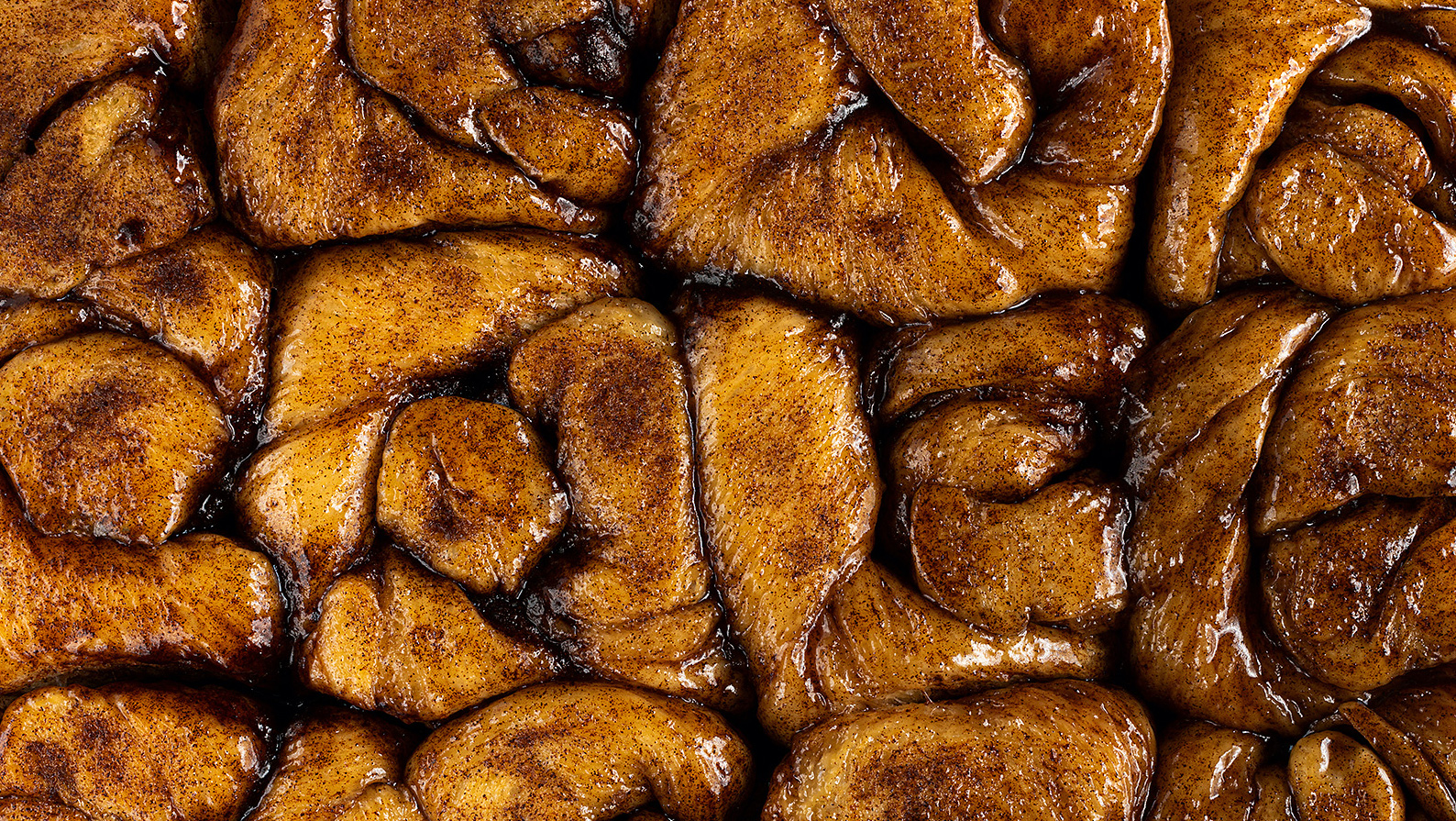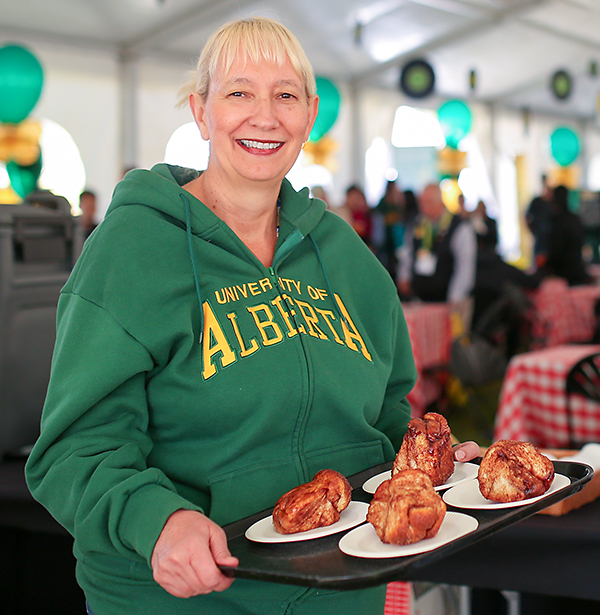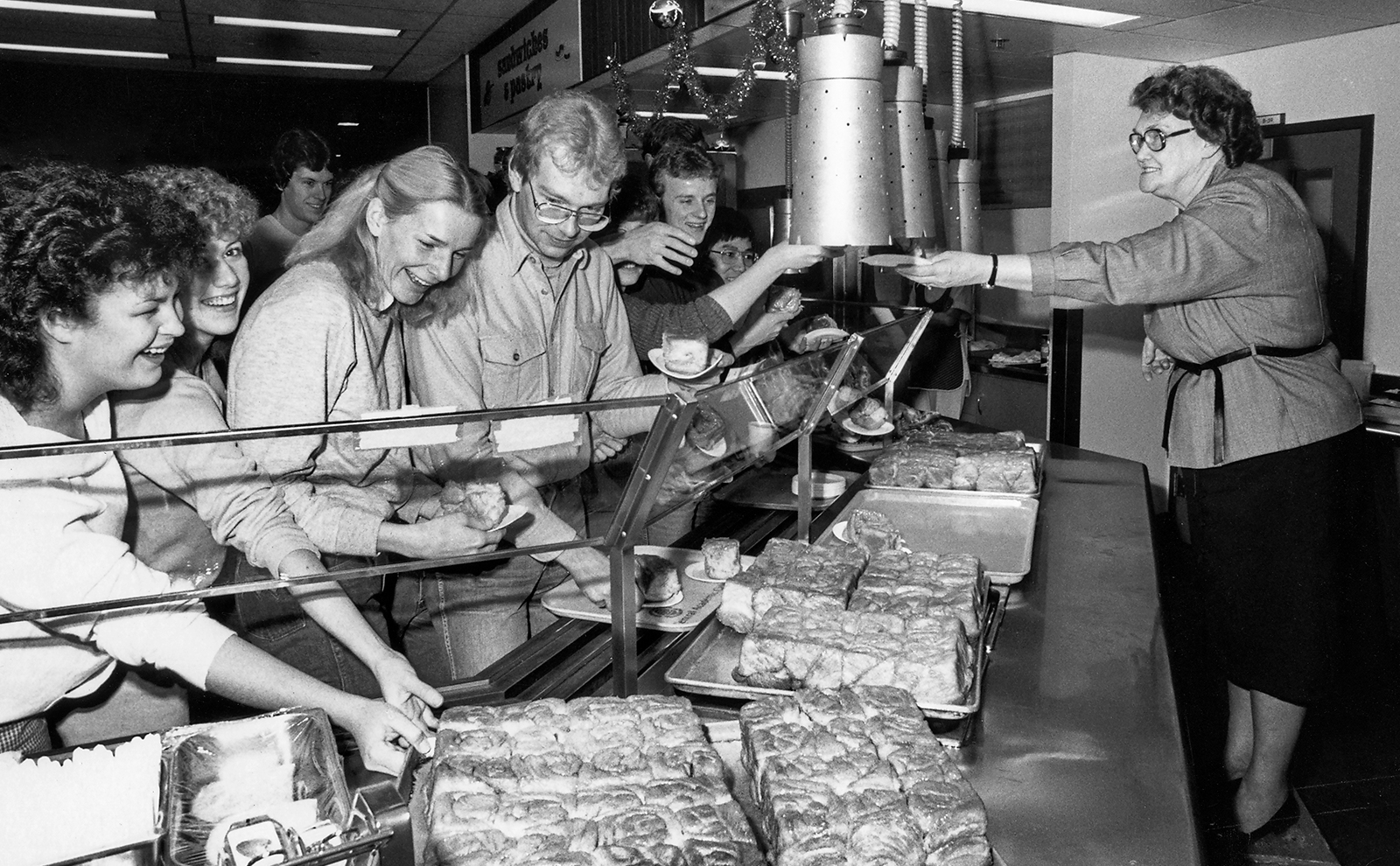Lorraine Huntley was fresh out of cooking school in 1977 when she was offered a job by the iconic University of Alberta food services manager, Joyce Kerr. Without knowing what a fervent house of worship she was entering, Huntley took the job and was soon doing well enough under Kerr's exacting eye that she was elevated to the role of Holy Knot-Maker. The cathedral – the Central Academic Building, or CAB – had been serving its sacred cinnamon buns since 1971 in the basement cafeteria.
Every day, working in the sepulchral depths of the temple where the buns were produced and sold, Huntley got a good look at the people for whom she was tying the knot: hordes of students so desperate for a bun that it was as if that baked knot of dough, sugar and cinnamon was all that separated pass from fail. (And as she gently reminds me when we talk, they were technically knots, not buns nor rolls.) Huntley recalls that they were delicious, huge and cheap. For a quarter, a student on a tight budget would get enough calories to last the day.
Some days it must have seemed as if every soul on campus was in line. Depending on the day of the week, Kerr, Huntley and the third Sister of the Order of the Holy Dough, Shirley Kaminski, would bake upwards of 50 dozen buns. The pans were empty by noon.
"There would be lineups!" Huntley recalls with a laugh. "We sold so many of them that Mrs. Kerr told us once that those buns paid our wages." The rush sometimes induced a state of near panic in the front counter staff. "We'd be working away in the kitchen and every so often one of the girls from the front counter would yell back into the kitchen, 'Are they ready yet? Are they ready?! Are they done?!' "
Not that they rushed. Kerr was old school and it rubbed off on her staff, says Huntley. Kerr perfected recipes. She ran a fastidiously clean and organized kitchen. And nothing got wasted, ever, an ethos that her staff adopted to varying degrees. One time, Huntley recalls, there was a bomb scare and the building was evacuated. Outside, Kaminski began to get nervous. She had 16 dozen buns in the oven. Huntley was standing beside her.
"She started to go back inside, and I said, 'Shirley, let them burn,' and she said, 'There's no way I'm letting 16 dozen buns burn.' And so she went back in while the alarm was still going, pulled the buns out of the oven and came back outside."
If Kaminski hadn't gone back in - a brave culinary marine determined to leave no buns behind - a student probably would have done so in her place. Former students remember the cinnamon buns with the kind of passion normally reserved for first loves.
Edmonton writer Marty Chan, '90 BA(Spec), penned an ode to the CAB buns in the Autumn 2017 issue of New Trail, in which he wrote that the buns "changed my life" when he realized he was organizing his days around the buns and, as a result, failing his engineering classes. Using his devotion to the buns as his inspiration, he switched to English and soared.
Over the years, grads have shared many a bun memory in New Trail. "Those buns got me through six years of early-morning lectures," reminisced Tom Fan, '81 BSc(MechEng), '83 MSc. Wrote Katherine Orrell, '81 BA: "I worked in campus mail during the summer and I would take a break between my rounds and grab one … the most delicious buns ever!" Teri Nichol, '87 BEd, became "instantly addicted" after her first bun and said, living in New Zealand, that thoughts of the buns made her homesick. "Just the smell of them made me feel able to cope with the full workload I had."

The origins of the iconic treat stretch back much further than the CAB cafeteria to the Tuck Shop, a café/corner store on the eastern edge of university campus originally set up in 1917. Tuck, as it was colloquially known, had a colourful history. It had been privately owned by an assortment of bookmakers and undertakers. According to reports through the years, Tuck at various times housed a basement dance hall, a chicken coop inside the building proper and a set of old streetcar rails that stuck out from the north side of the building. Over many decades and through multiple transformations, the Tuck Shop was the main student hangout on campus.
"It was the centre of everything," Hugh Morrison, '30 BA, recalled of the Tuck Shop in the 2001-02 Winter issue of New Trail. He actually took a class in Tuck. "There were only four of us, and we would meet with our professor - who was young, himself - at Tuck." The buns were a definite draw, according to Joseph Rapaich, '67 BSc(MechEng), who told New Trail in 2018: "While attending U of A, a group of us lived two doors down from the Tuck Shop and enjoyed many, many, many of those famous buns."
Tuck even played a role in the writing of our provincial history. Peter Lougheed, '51 BA, '52 LLB, '86 LLD (Honorary), was apparently besotted with a young lady who appeared on the cover of the U of A phone directory one year. Her name was Jeanne Rogers, '51 BA. They had a mutual friend named Dunc Stockwell, who arranged a meeting between the two at (where else?) the Tuck Shop. They would, of course, go on to get married and play a dynamic role as a couple in shaping what Alberta is today.
The U of A took over running the Tuck Shop in 1968. When the building was demolished in 1970 to make way for the Fine Arts Building, two things survived. One, thankfully, was Kerr, who ran the Tuck Shop in her role as food services majordomo. The second, thanks to Kerr, was its iconic bun. As New Trail reported in 1982, Kerr was the right person in the right place at the right time to save Tuck's buns, as it were.
In 1968, when the university had acquired the Tuck Shop, Kerr became manager of the lunch counter. "And there the fateful meeting took place…. She perfected and standardized the bun recipe, and when the Tuck Shop closed she ensured it would have a legacy by making the Tuck Shop Cinnamon Buns a feature of the new CAB Cafeteria," the story notes. While the provenance of the original bun recipe is lost in the yeasty mists of time, it was Kerr - who ran a test kitchen in SUB that developed and tested recipes for all campus food operations - who created the recipe for the CAB buns that alumni came to know.
Like many iconic cultural signifiers of past and present that we tend to accept without ever truly unpacking the why and how of their hold on us - Elvis, the Cold War, the Kardashians - the Tuck Shop bun is shrouded in mystery, beset by persistent rumour, subject to misinterpretation and even misattribution, and even sometimes challenged by pretenders to the throne.
Michael Hinz, '64 BEd, remembers an outlet called Hot Caf, roughly where the west end of CAB is today, where his mother worked as a baker. "One of the major attractions was the cinnamon buns that came out of the oven at 10 a.m. Students lined up for them!" Hinz recalls them as being very different from the Tuck Shop buns - they had raisins and were buttery. There is no record of cross‑fertilization between Tuck and Hot Caf.
Java Jive in HUB also served an impressive cinnamon bun, supplied by Dagmar Kuehn, who ran the Sugarplum Pantry from 1982 to 1997. Kuehn notes that she loved the Tuck Shop buns but used a slightly different recipe. (I can verify that the buns were rabidly consumed, as those were roughly the years I attended the U of A and, being an arts student, I tended to hang out in HUB rather than CAB.)
As for conspiracy theories, perhaps the most persistent still in play today is that the Tuck recipe was somehow airlifted, stolen, put on microfilm and probably put on CinnaLeaks by Edward Snowden expressly for use by the Highlevel Diner and the Sugarbowl, which sit close together just east of campus. Some have said that the cinnamon buns are, if not outright copies of the Tuck bun, at least its progeny.
Not so, says Kim Franklin, co-owner of the Highlevel Diner. "In fact," she tells me via email, "there is no truth to the story that our recipe comes from the Tuck Shop on campus. Our buns have nostalgically been compared to them but it is not the same recipe." Their recipe came from Toronto along with their first baker, she says.
It would seem logical to connect the two, given that the Diner bun and the Tuck bun share a certain girth and knottiness. But no, says Franklin. Pure happenstance.
Which would also then apply to the Sugarbowl bun, since it's derived from the same Diner recipe. Abel Shiferaw owns the Sugarbowl and tells me, over a Bowl bun and a coffee, that a Highlevel Diner employee brought the recipe with him when he reopened the Sugarbowl in 1988, though it was modified slightly over the years.
Decades of investigative reporting on this subject have demonstrated that the Highlevel Diner bun and Sugarbowl bun are Tuck-worthy representatives of the art, yet different even from each other, the Sugarbowl bun being denser and more buttery. Which illustrates just how different buns can be, even when they use the same basic ingredients and originate from the same recipe.
And here we come to the knotty side of the story. In theory, it doesn't seem that complicated to make or eat a cinnamon bun (follow a recipe, open your mouth), until you stop to think about the individual histories and memories that every bun seems to carry along with it: the stories, recipes, myths, rumours and reminiscences.
Why is the Tuck Shop bun so powerful, exactly? Well, because it functions on so many levels. Obviously, the buns are delicious. But they are also symbolic. They are a shorthand reference that allows us to communicate with our past and present - the scent of the stories we tell about ourselves.
Yet as much as we might wax poetic, it turns out that it's not nostalgia that brings on a rush of fond memories when we smell a cinnamon bun like the ones we ate as university students. It's biology.
I spoke with U of A researcher Clayton Dickson about what is actually happening inside our brains when we get a whiff of a scent reminiscent of one of those old Tuck Shop buns. Dickson is a professor in the departments of psychology and physiology and a member of the U of A's Neuroscience and Mental Health Institute.
Smells can call up deeply rooted memories from our past, he says. Smell is one of our most powerful senses and has even followed a different evolutionary path than our other sense.
Other senses take gravel roads to get to the brain, but smells take the neural autobahn to the temporal lobe cortex, registering as both sense and memory.
To condense decades of brain research into a few paragraphs: sight, sound and touch are all processed through various specialized pathways before they can check in at the brain. But smells, says Dickson, go straight to our olfactory bulb, which essentially has two projections emanating from it. One goes to the olfactory cortex to download smells. The other, incredibly, drives straight into one of the older parts of our brain, the entorhinal cortex, which is one of the front doors to the hippocampus and the two medial temporal lobe regions that have evolved to hold episodic memory.
In other words, our olfactory bulb connects to parts of the brain that process sensation and also to the parts that house memory. Which is why powerful scents can so instantaneously transport us across decades and continents to scenes so vivid they could be happening right in front of us. Other senses take gravel roads to get to the brain, but smells take the neural autobahn to the temporal lobe cortex, registering as both sense and memory.
It's even more amazing and mysterious than that. Dickson tells me researchers are conducting experiments on the connection between scent and memory in which people are given a task while, unbeknownst to them, a positive scent is pumped into the room. Later, while asleep and hooked up to brain monitoring machines, the scent is pumped into the room, at which point their hippocampus activates. The next morning, the subjects typically have better recall of the previous day's task.
"Our brain is screening the movie over again, in our memories, activated by a simple scent," says Dickson.
Which is why the smell of cinnamon and sugar and yeast so deliciously combined can not only make somebody hungry, it can also whisk them back decades to their lives as students, waiting anxiously in line in CAB: I am so hungry I might pass out, when are the buns going to be ready? I might cry if they run out, man, I am so late for class, is that actually snow falling out there, I wonder if Suzy will acknowledge my existence today, I need to get those overdue library books returned, oh, here come the buns! Memories ignited with dizzying immediacy and a microscopic attention to detail that is both soul-filling and a bit spooky.
And you thought this story was just about cinnamon buns.
The Tuck Shop bun was served in CAB until 1994, when food services on campus were privatized, says Huntley. Kerr had retired by then and Huntley had moved to a different department. The Tuck bun was made no longer, but it hardly faded from memory. Huntley still gets wistful inquiries a few times a year from alumni waxing nostalgic, and she still makes the buns occasionally on special request (including for Alumni Weekend 2019 this past September). Students who swarmed CAB may never have set foot in the original Tuck Shop, but the Tuck legacy and a vital strand of U of A history lived on in their mouths and nostrils. And, as alumni, in their memories.
Kerr died in 2012. Her granddaughter, Melissa Wolski, has fond memories of spending the day with her grandmother making cinnamon buns. She and Huntley remain among the few who can say they've had a hands-on demonstration from Kerr. At a conservative estimate, Huntley has tied more than a million knots over the years. (She even made the buns photographed for this story.) "They have to be hand‑cut and hand-tied. And if they aren't made right, they're not Tuck Shop cinnamon buns," she says. It's the kind of knowledge that seems almost inconsequential upon first brush, but the closer we get to losing it, the more it takes on an aura of profound learning. Who is going to have it in their hands to make the Tuck Shop bun once Wolski and Huntley no longer feel the knead?
If collective memory can be transmitted in a scent, then the Tuck Shop bun was considerably more than a hunk of dough, sugar and cinnamon. It represents a time of life that memory and nostalgia tend to airbrush ever so slightly; a time that, for many, was particularly meaningful. The thrilling intellectual discoveries of a university education. The first blushes of young love. The excitement of becoming who we are meant to become.
What could possibly capture the intellectual and emotional content of such an important stage of life? Books? Music? Friends made and lost? Yes, all of these.
But in the end, perhaps it would be best to simply follow our noses.






We at New Trail welcome your comments. Robust debate and criticism are encouraged, provided it is respectful. We reserve the right to reject comments, images or links that attack ethnicity, nationality, religion, gender or sexual orientation; that include offensive language, threats, spam; are fraudulent or defamatory; infringe on copyright or trademarks; and that just generally aren’t very nice. Discussion is monitored and violation of these guidelines will result in comments being disabled.